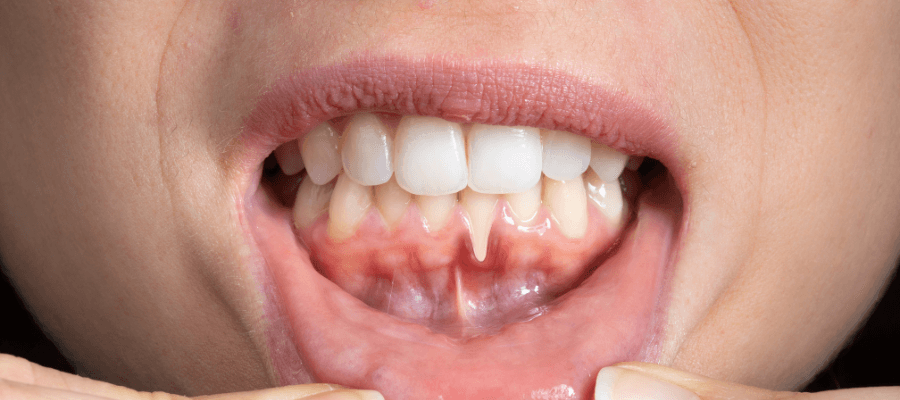Have you ever noticed your teeth looking a bit longer than they used to? Maybe you’ve felt a twinge of sensitivity when sipping a cold drink or brushing your teeth. These could be signs of receding gums, a sneaky dental issue that can creep up quietly but have a big impact on your oral health.
Let’s break down what receding gums are and, more importantly, what causes them so you can take steps to protect your smile.
What Are Receding Gums?
Receding gums happen when the gum tissue around your teeth starts to wear away or pull back, exposing the tooth’s root. Unlike the crown of your tooth, which is covered in tough enamel, the root is more vulnerable. It’s darker in color, more prone to decay, and often sensitive to hot, cold, or even the bristles of your toothbrush.
As gums recede, they can also form “pockets” or gaps between the teeth and gum line. These pockets are like open invitations for bacteria to settle in, potentially leading to gum disease or, in severe cases, tooth loss.
The tricky thing about receding gums is how gradually it happens. You might not notice it until a tooth looks noticeably longer, you feel a notch near the gum line, or sensitivity starts bothering you. For many, it’s a silent problem that flies under the radar until it’s advanced.
What’s Causing Your Gums to Recede?
So, what’s behind this gum retreat? Several factors can contribute, and understanding them is key to stopping the process in its tracks. Here are the main culprits:
Gum Disease
The leading cause of receding gums is gum disease, often triggered by plaque buildup from poor oral hygiene. When bacteria linger on your teeth and gums, they can irritate and inflame the tissue, causing it to pull back over time. If left untreated, this can damage the supporting bone and tissue around your teeth, making gum disease a serious threat.
Overzealous Brushing
Brushing too hard or using a toothbrush with stiff bristles can do more harm than good. Aggressive brushing wears down delicate gum tissue, causing it to recede. If you’re scrubbing like you’re cleaning a stubborn pot, it’s time to ease up! Switching to a soft-bristled toothbrush or an electric one with a pressure sensor, can help you clean effectively without damaging your gums.
Insufficient Oral Hygiene
On the flip side, not brushing or flossing enough allows plaque and tartar to build up, irritating your gums and contributing to recession. It’s all about finding the right balance—clean thoroughly, but gently.
Trauma or Physical Damage
Physical trauma, like an injury to the gums from an accident, aggressive flossing, or even habits like teeth grinding (bruxism), can cause gums to recede. Misaligned teeth can also put uneven pressure on gums, leading to gradual recession.
Other Contributing Factors
Things like hormonal changes, tobacco use, or even genetics can play a role in gum health. If your family has a history of gum issues, you might be more prone to recession, so extra vigilance is key.
How to Spot and Stop Receding Gums
The first signs of receding gums are often subtle: a tooth that looks longer, a notch you can feel near the gum line, or new sensitivity to hot or cold. If you notice these, it’s time to act. Visiting your dentist for a checkup can help catch the issue early and prevent further damage. They might recommend professional cleanings, scaling, or even adjustments to your brushing technique.
At home, make sure you’re using the right tools. An electric toothbrush with a pressure indicator, can be a game-changer for preventing further recession caused by aggressive brushing. Pair it with regular flossing and a gentle touch to keep your gums healthy.
Take Control of Your Gum Health
Receding gums might start small, but they can lead to bigger problems if ignored. By understanding the causes—gum disease, improper brushing, trauma, or other factors—you can take proactive steps to protect your smile. Start with a gentle, consistent oral hygiene routine, and consider upgrading your toothbrush to one designed to keep your gums safe.
See a Dentist
For Gum Assessment in Brisbane make sure to contact our dental clinics at Park Road, Milton and Buranda Village, Woolloongabba.
We are open and ready to accept patients from Brisbane, Milton and all other surrounding areas like Bardon Indooroopilly, Kenmore, Auchenflower Toowong, St. Lucia, Southbank, West End, Dutton Park, Coorparoo, Fairfield, Greenslopes, Annerley, South Brisbane, Stones Corner, Mount Gravatt East, Holland Park, Highgate Hill and Brisbane CBD.

